|
Some basics for bootmen

Boot Terminology |
| Have you ever been confused by some terminology
describing different parts of boots? You're not alone. Here is a
guide to the most frequently used terms and even some esoteric references, too.
Links are in blue. These go to other web pages.
Boot terms are in red. The terms are defined in
the paragraphs below.
|
| |
| BOOT SHAFT |

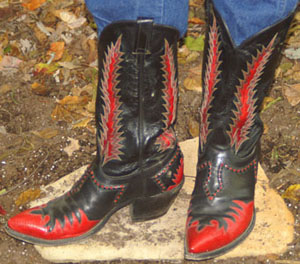
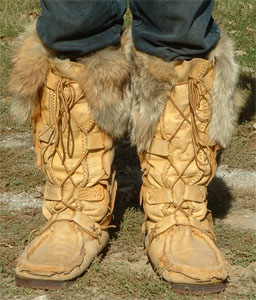
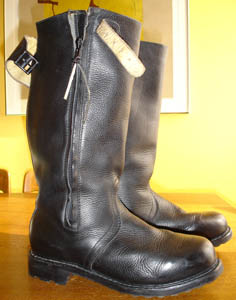
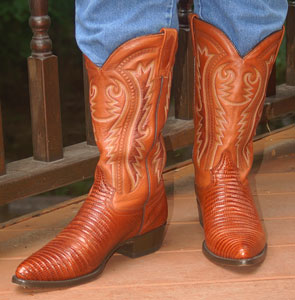
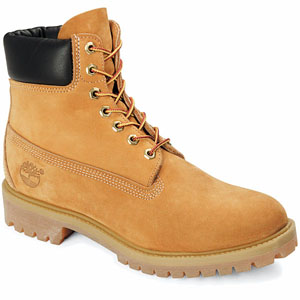
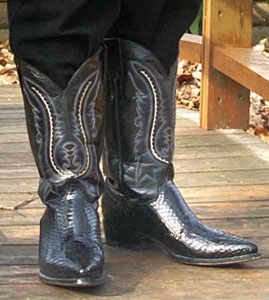
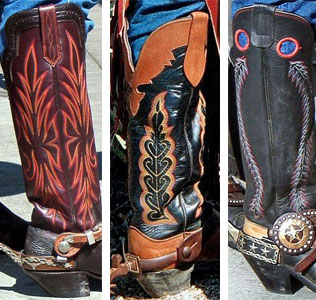
| The Boot Shaft is the part of the boot
that covers your leg. It has two measurements. The height is
taken on the inside seam of the boot, and is measured from where the
shaft meets the sole of the boot, to the top of the shaft. To determine
where the top of a boot will hit on your leg, measure the height of the
shaft against the inside of your leg, starting at your instep. The
circumference (sometimes called
calf size) is the
measurement around widest part of the shaft of the boot. To see if
tall boots will fit your calves, measure around the widest part of
your calf, and compare your measurement to the shaft circumference.
An overlay and inlay are
decorative work involving multiple layers and colors of leather. See the section on
the Upper (Vamp) below for more information on these designs.
A zipper or buckles may
be used on the side or back of a boot shaft to facilitate making a boot easier to put
on or take off.
A liner (or lining) may be sewn on the inside of the
shaft for added strength and stiffness, as well as to increase water resistance.
Liners on the inside of boot shafts are usually made of soft cowhide leather.
But some liners for boots like Mukluks
may be made of fur or synthetic materials. Some German Air Force
Knobelbecher Boots had a shearling lining,
which is processed soft sheep wool. A drawback of lined boot shafts is that the
lining can limit moisture from leaving the boot.
A back stay is a strip of leather that runs up and
down the back of the inside of the boot lining to stiffen and support the boot
and hold up the top, which gets the most movement.
Shafts on boots like cowboy boots may also
have fancy stitching of various and contrasting colors
sewn into the shaft. Such stitching makes boots very distinctive. Some particular
brands of cowboy boots use stitching patterns unique to them which some discerning
Bootmen can distinguish.
Piping is a rounded strip of leather that runs up
the side seams of some types of boots. Sewn dead center between the back and
front of the boot, piping can be in the same color or a contrasting color of
leather to make the boot or its stitching patterns stand out more. Piping is also
used to hide stitching that holds the side seams together.
Boot shafts are finished differently at the top:
Hiking and work boots may have a padded collar that
cushions the ankle and the Achilles tendon. The collar limits rocks and mud from
entering the boot while hiking on rocky terrain.
Other boots finish the top of the boot shaft in what is called a
scallop. A scallop can be flat, called a stovepipe because
the boot shaft looks like an old-fashioned stovepipe.
Biker Boots usually have a stovepipe
scallop. Cowboy Boots often have a v-shaped
(sometimes called a dip) or other
type of scallop. There are as many as eight different types
of shaft scallops on boots.
Scallops may be finished with beading, which is a
slender, rounded strip of leather that encircles the top of the boot. The beading
is most often made from the same material as the piping that runs down the side of
the boot.
Some pull-on boot shafts may have features to help the wearer pull the
boot on. These include:
- A pull tab is usually a strip of
leather stitched around the left and right side of the shaft. A pull tab may be
the same color as the shaft color, or a contrasting color.
- Mule ears are longer strips of leather that look
like the ears of a mule. These are found on some
cowboy boots like buckaroos.
- Shaft holes are just what their name says -- two
holes near the top of the right and left side of the boot shaft. Buckaroo cowboy
boots often have shaft holes.
- Inner pulls are usually made of synthetic fabric
and are sewn inside the right and left sides of a boot shaft, such as on a pair of
police patrol boots. A Bootman will often
use a pair of boot hooks to grab each inner pull to
pull the boot on, especially if boots will be worn over pants such as breeches.
|
| |
| UPPER (VAMP), TOE BOX, TONGUE, AND KILTY |

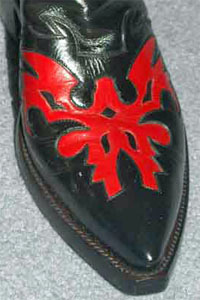
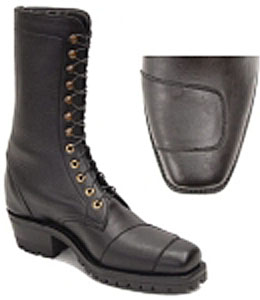
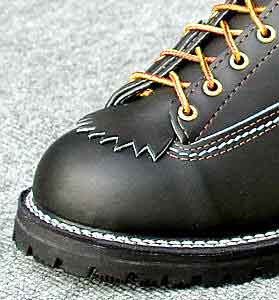
|
The upper, also called a vamp, surrounds and
protects the foot from the sole up. Uppers are built around a
last, which is a mold used to shape the boot's materials.
Some boots are made with a single layer of material (single vamp),
a double layer (double vamp), or even triple layer (triple vamp) for added insulation and water penetration resistance.
The upper attaches to the heel counter in the back, and to
the front parts of the boot top in the front.
Other components of the upper may include the parts listed below,
but these parts are not on all types of boots.
The toe, described in the section about boot toes
below.
The heel box, described in the section about boot
heels below.
An overlay and inlay are
decorative work involving multiple layers and colors of leather. These may be overlaid
or underlaid. Overlay patterns are sewn over the principal boot leather (overlaid),
while inlay patterns are sewn in from underneath (underlaid) to produce a cutout
window-type design. Overlays and inlays may be on the upper (vamp) and on the boot
shaft.
A specialized type of overlay is a motorcycle shift guard
which is an added layer of leather sewn on to the upper of the left boot of a pair of
some brands of biker boots. The shift guard is
designed to provide protection to the boot and the foot of a motorcycle rider who
uses a foot-operated shift lever on the left side of a motorcycle.
A liner built into the upper to increase water
repellency. Liners may be used on boots with fabric uppers, like
hiking boots. The drawback of liners is
that they can limit moisture from leaving the boot.
The tongue folds under boots with the laces when tied.
A fully gusseted tongue joins the tongue to the leather body via
flexible leather, keeping water and dirt out of the boot.
A kilty or false tongue
is an 8" (20 cm) strip of leather with a serrated edge at the bottom which is held in
place by the bootlace as it passes through the bottom eyelets. Kilties were
originally intended to provide padding between the bootlaces and the instep of the
foot in logger boots. This was necessary in
boots which used thin leather for the tongue and also protected the tongue from wear
by the laces.
|
| |
| BOOT TOES |
|
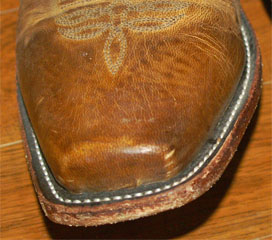
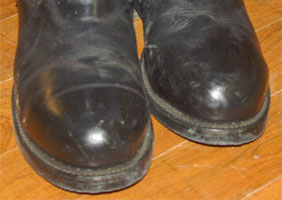
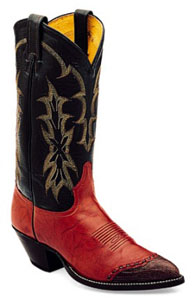
| The boot toe is the very front
end of the boot. Toes can come in as many as
12 different styles,
varying from ultra narrow (X-toe) to wide and round (W-toe). The most variation in
boot toes are found on cowboy boots.
Here are other features of boot toes:
The toe box surrounds and protects the wearer's toes.
It is a stiff piece of material that is placed in the top of the boot toe between
the outer vamp leather and the lining to reinforce the shape. The heavier the boot
weight, the more protection.
A steel toe is a piece of steel molded on the inside
of the boot's toe box, usually between two pieces of leather in a double-vamp boot.
A steel toe provides reinforcement and protection to the wearer's feet.
A toe rand, also known as a
toe cap, is an optional piece of metal nailed on to the
front toe of a cowboy boot. Toe rands or caps are added for appearance and styling.
They may be made of various metals such as aluminum, silver, or gold, or metal alloys.
A toe bug is a design stitched onto the top of the
vamp of many cowboy boots so you can see it when
you look down at the boot.
A wingtip is on some
cowboy boots, and is usually a contrasting color of
leather found at the toe. A wingtip usually is in a V-pattern and looks like the edge
of a bird's wing.
|
| |
| HEEL, COUNTER, HEEL LIFT, AND SPUR RIDGE |
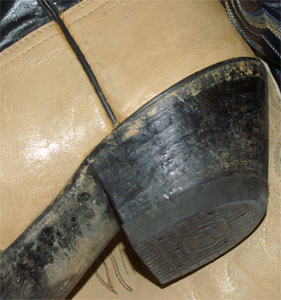
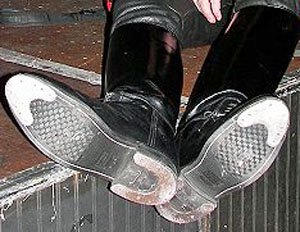
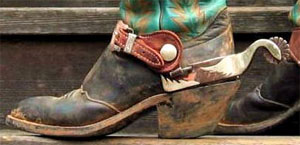
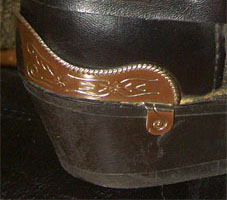
|
Boot heels are specially designed for
a particular type of boot. Cowboy Boots can have
as many as 13 different
types of heels, ranging from low, flat, short block heels to 3" or higher
underslung heels. Other boots usually have a heel
that matches the style of the boot. For example,
engineer boots usually have a rounded
block heel of about 1" - 2", usually finished with a
rubber heel lift on the bottom.
Hiking boots usually have the heel integrated
with the rest of the boot sole and has little difference in height from the rest
of the sole.
Other parts of a boot related to the heel include:
The heel cup, or heel counter,
that holds and supports the heel, assisting in minimizing lift when walking and
offers ankle stability.
A heel lift is a protective cap or pad, usually made
of rubber, attached to the bottom of the heel on most (but not all) boots. Heel lifts
are usually from 1/8" to 1/4" in thickness.
Taps are sometimes found on boots. A horseshoe tap may be used on the heel, and a
rounded tap may be used on the sole at the toe.
The purpose of taps on boots is to prevent wear, and they're also used for sound,
so that the Bootman can be heard walking in his boots.
A heel pad is a thin piece of leather that is glued on
the inside of the boot, on top of the insole. It protects the insole at the heel
from excessive wear.
A spur ridge is a small "ledge" or part of a boot heel
that sticks out behind the bottom of the boot shaft onto which a spur may be worn.
The ridge helps to prevent the spur from falling below the heel, especially when
mounting or dismounting a horse.
A heel rand, also known as a
heel cap, is an optional piece of metal nailed on to the
back of the boot where the heel meets the bottom of the boot. Heel rands or caps
are added for appearance and styling, usually on cowboy boots. They may be made of
various metals, such as aluminum, silver, or gold, or metal alloys.
|
| |
| BOOT SOLES |
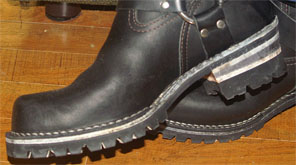


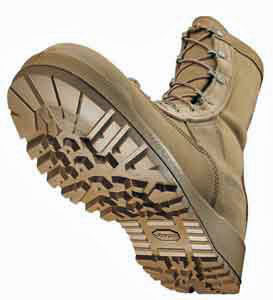
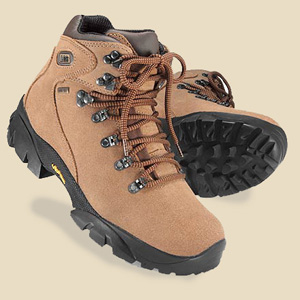
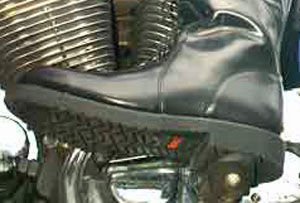

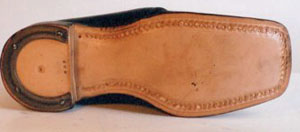
|
The boot sole is the only part of the boot
besides the bottom of the heel that actually has contact with the ground. As such,
boot soles are usually made of very sturdy materials that can withstand constant
wear and tear, and will not be easily penetrated by debris on the ground.
A boot sole is composed of three parts:
The outsole which is the part that touches the ground.
Outsoles may be made of leather, rubber, or synthetic materials.
- Leather soles are usually found on
cowboy boots and boots like those built on the Wellington design. The leather is
usually thick and smooth. New boots with leather soles may slide on carpet or
polished floors. Leather soles make for a dressy appearance.
- Rubber soles are found on boots used by bikers and hikers,
among others. Boots with rubber soles provide good traction and resistance to
penetration by rocks or road debris.
- Lug soles are made from a special type of hard,
durable rubber. One particular and highly popular type of lug sole is called a
Vibram® sole. This is a lug sole with a particular
tread pattern and diamond-shaped sole insert. Lug soles provide superb traction.
- Waffle soles may be found on
hiking or
combat boots. They are also made of leather,
but the pattern is crossed like a waffle. These soles resist accumulating
dirt or mud between the treads.
The midsole is a layer of synthetic, leather,
or fabric material that stabilizes the boot and supports the foot with shanks.
A shank is a metal or heavy plastic strip in the sole
used as reinforcement for the wearer's arch. It provides support for the bottom
of the boot. A full shank goes to the toe while a 3/4 shank goes to the
ball of the foot. Shanks can be plastic or steel. Most bootmakers today
use a thin, precut strip of eighteen-gauge steel, which is glued,
whipstitched, or tacked in place.
The insole directly contacts and cushions
the foot inside the boot and is often removable. Insoles are usually made
of a soft synthetic material, or may be made of leather, fur, or wool.
Sometimes Bootmen have complained about their feet hurting inside boots.
Replacing the original insole with a new one may relieve that problem,
particularly if a new type of insole is used such as one with gel inserts.
Boot soles are attached to the upper with either stitching or glue.
Stitching provides stiffness to the boot. Stitching also allows worn soles
to be replaced easily. Gluing, or cementing, soles to the upper is not as
durable as stitching, but is less heavy and more flexible.
In hiking boots, a piece of rubber covering
the joint between the upper and the boot sole is called a
rand. It is not the same thing as a heel or toe rand
on a cowboy boot, but has the same shape. A rand protects the joint between the
upper and the boot sole and has a tight seal to ensure water resistance.
Welt or welting is a strip of heavy leather that is
sewn around the lasting space of the upper and joins it to the insole. The sole is
then stitched to the welt with a second seam. The welt is also known as the "rand"
in cowboy and many other styles of boots. Inseaming thread
(a waxed flax or polyester thread which will lock in position when stitched tight)
is used to stitch the welt to the upper and the sole of the boot.
A pegged sole has wooden pegs made from maple or
lemonwood driven through undersized holes, completely piercing the outsole, upper
and insole. Then the pegs are floated (smoothed) off on the interior of the boot.
These pegs, in rows of one to three deep, run along the arch (shank) of the boot
down to the heel. Along with stitching and glue, they hold the insole and
outsole together. Pegs are usually a sign of a better-quality boot. If a
boot sole is pegged, one can see the tops of the pegs when looking inside
the boot.
|
| |
|
Content from Booted Harleydude. Pictures from DaveM,
Booted Harleydude,
Big Black Boots, and
Champion Attitude Boots. These are used
with permission. A few other pictures are from various publicly available internet
sources.
Text from About.com/Shoes,
Bass Pro Shops,
Champion
Attitude Boots, and the internet article titled
How a Cowboy
Boot is made. Specifics referenced in the latter internet page use
references from two books: The Art of the Boot and The Cowboy
Boot Book by Mr. Tyler Beard from which content on this page is quoted.
|

Tutorial - Types of Boots
Boot Information Resources
Boot Information Page Index
|

